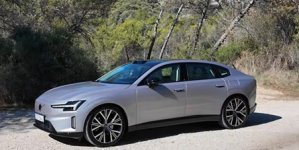Volvo ES90 (2025) Review – Luxury Electric Fastback or Crossover Sedan?
Overview
The 2025 Volvo ES90 is the brand’s new electric flagship — a model that blends sedan elegance, fastback practicality, and SUV-like versatility. Volvo calls it “a refined electric grand tourer that merges comfort, efficiency, and modern Scandinavian luxury.”
It’s built on the SPA2 platform (shared with the EX90 SUV) and uses Volvo’s latest NVIDIA Orin computing system, enabling advanced driver-assistance and over-the-air software updates.
Design & Innovation
- Signature Thor’s Hammer LED headlights and C-shaped rear lights.
- Liftback design for easier cargo access, replacing the traditional sedan trunk.
- Low drag coefficient of 0.25, improving range and efficiency.
- Available 20–22-inch wheels, with a slightly raised stance.
- Cabin made from recycled fabrics, FSC-certified wood, and animal-free materials — a hallmark of Volvo’s eco-friendly approach.
- Overall, the ES90 looks like a luxury sedan with a touch of crossover utility.
Performance & Range
- 800-volt electrical system allows up to 350 kW DC fast-charging, recovering 10–80 % in ≈ 20 minutes.
- Battery packs: ≈ 92 kWh (net) RWD / ≈ 106 kWh (net) AWD.
- Range: up to ≈ 700 km (≈ 435 mi, WLTP) depending on trim.
- Powertrains: single-motor RWD or twin-motor AWD (Performance version ≈ 4.0 s 0–100 km/h).
- Suspension: adaptive dampers and air suspension (in higher trims) deliver comfort and stability.
- Reviewers note confident, planted handling though ride height is slightly taller than a classic sedan.
Acceleration & Handling
The twin-motor ES90 offers brisk acceleration and surefooted traction, while steering remains light yet precise. Adaptive suspension smooths rough roads effectively, balancing sporty feel with Volvo’s trademark calm composure. The higher seating position gives a more commanding view than traditional low-slung sedans.
Safety & Driver Assistance
- Equipped with Volvo’s Safe Space Technology suite: 1 lidar, 5 radars, 7 cameras, 12 ultrasonic sensors.
- NVIDIA Orin processors manage ADAS and data from all sensors for real-time analysis.
- Driver-monitoring cameras detect drowsiness or distraction.
- Occupant detection warns if a child or pet is left inside.
- Over-the-air updates continually refine safety features.
- Crash-test results are pending (Euro NCAP expected 2025-2026). Volvo’s record suggests top ratings once tested.
Interior & Technology
- 14.5-inch central touchscreen with built-in Google Maps, Assistant, and Play Store.
- Digital driver display + optional head-up display.
- Bowers & Wilkins premium audio (available on higher trims).
- Spacious rear cabin: generous legroom, optional heated/ventilated seats, multi-zone climate.
- Cargo space: ≈ 424 L behind rear seats, expandable via flat-folding seats.
- Sustainability: recycled textiles, bio-based polymers, and responsibly sourced aluminum.
- Reviewers praise the calm, minimalist design and comfort, though some miss physical buttons due to heavy touchscreen reliance.
Infotainment & Connectivity
- The system runs Android Automotive OS, supporting OTA updates.
- Seamless integration with Apple CarPlay and Android Auto.
- Built-in voice assistant handles navigation, temperature, or seat controls.
- Fast 5G connectivity for navigation and media streaming.

Sustainability & Efficiency
- Zero tailpipe emissions – fully electric drivetrain.
- Eco-friendly materials: recycled plastics, plant-based fabrics, leather-free interiors.
- Low drag + 800 V architecture → better energy efficiency.
- Volvo provides a battery passport detailing raw-material sourcing and recycling plans.
- Target energy use ≈ 15–16 kWh/100 km (WLTP), positioning it among the most efficient in its class.
Customer Impressions & Early Reviews
Because deliveries start late 2025, owner feedback is limited, but early test drives highlight:
Pros
- Elegant Scandinavian styling
- Excellent material quality and quiet ride
- Long range + ultra-fast charging
- Strong safety tech and driver-assistance
Cons - Slightly elevated driving position (less “sport-sedan” feel)
- Touchscreen-heavy controls
- Pricing likely at the upper end of the luxury-EV bracket
“It’s less a traditional sedan and more a grand electric fastback — calm, composed, and convincingly premium.”
Competition
Main rivals include:
- BMW i5 – sportier handling, shorter range
- Mercedes-Benz EQE – softer ride, heavier design
- Audi A6 e-tron – comparable tech, less cargo space
- Tesla Model S – faster but less refined interior
Compared with these, the ES90 offers a more balanced mix of comfort, efficiency, and Nordic design simplicity.
Availability & Pricing
- Global launch: Q4 2025, European deliveries from early 2026.
- Pricing not yet official, but expected to start around €75,000–€85,000 in Europe depending on battery and trim.
- U.S. base price forecast: ≈ $80,000–$85,000 for RWD, ≈ $95,000 for AWD Performance.
- Reservations: via Volvo’s online portal or local dealers; refundable deposits vary by region.
- Hungarian pricing will depend on local incentives and import duties; similar to the EX90’s premium positioning.
Conclusion
The Volvo ES90 is not quite a crossover, not just a sedan — it’s a luxury electric fastback that combines the refinement of a traditional saloon with the practicality of a liftback and the security of an SUV.
Strengths:
- Elegant design and sustainability focus
- 800-V architecture → lightning-fast charging
- Excellent range (~700 km WLTP)
- Benchmark safety and advanced tech
Weaknesses:
- Premium price
- Slightly taller stance than a pure sedan
- Heavy touchscreen interface
Overall, it’s one of the most advanced and eco-conscious executive EVs to arrive in 2025 — a perfect match for buyers seeking quiet luxury, safety, and next-generation technology in a distinct Scandinavian package.
Bench Dog Car Seat Cover for Back Seat Waterproof Seat Covers Durable Scratch Proof Nonslip, Protector for Pet Fur & Mud Washable Backseat Cover for Cars Armrest Compatible
